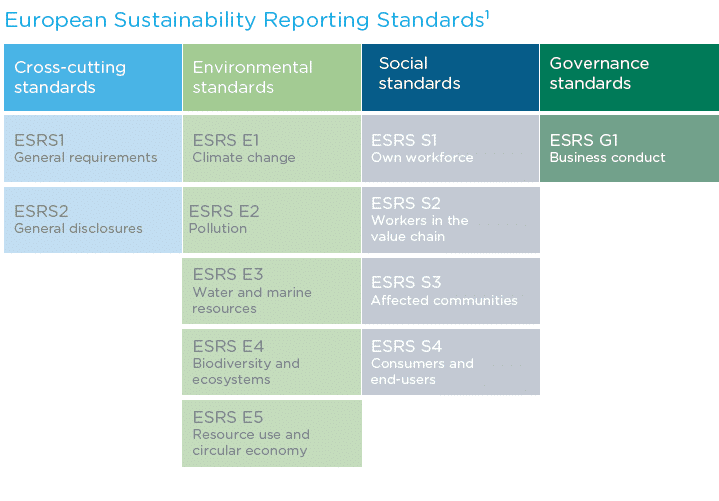If you already have published reports against the Task Force on Climate Related Financial Disclosures (TCFD), then following the general guidelines of your already established TCFD report will give you a good basis on writing a compliant CSRD report. However, there are some additions in the CSRD that are not fully addressed in the TCFD to keep in consideration.
Regarding the ESRS governance standards, TCFD covers all the basic conditions that need to be met, such as disclosing the company’s governance tasks regarding climate-related risks. However, the ESRS goes further to implementing overall corporate sustainability standards, expanding from the climate-only disclosures from the TCFD. Furthermore, the ESRS demands:
- That impacts be considered in addition to Risks & Opportunities,
- Remuneration directly tied to greenhouse gasses (GHG) emissions reductions targets in ESRS E1 direct requirements related to ESRS 2 GOV-3,
- Integration of sustainability-related performance in incentive schemes, and classified under Governance in ESRS rather than Metrics in TCFD,
- List of sustainability matters addressed by the undertaking’s administrative, management and supervisory bodies, section 24 (c) – Statement on sustainability due diligence (Disclosure Requirements GOV-4).
When it comes to making a sustainability strategy the TCFD demands the disclosure of actual and potential impacts of climate-related risks and opportunities on the company’s businesses, strategy, and financial strategies where such information is material which is also demanded by the ESRS as well. The ESRS expands on these disclosures by:
- Demanding that in addition to risks and opportunities, an impact assessment on the environment and society be considered,
- Making more explicit reference to compliance with the 1.5°C global warming limit,
- A more developed understanding of “locked in emissions” and “stranded assets,”
- Effects of climate-related risks on future financial position and business activities separated between physical and transition risks,
- ESRS E1 is more specific about targets and forbids the use of carbon credits and offsets to meet GHG emission reduction targets,
- Future financial effects of climate-related risks covering gross risks instead of net risks (before mitigation and adaptation policies, targets, and actions),
- Ratios of taxonomy alignment, consistency of financial opportunities and resources with data from taxonomy regulation,
- Disclosures about energy efficient real estate assets by energy-efficiency classes, a list of assets subject to acute and long-term physical risks, exposure to fossil fuel activities,
- Provides examples of potential assets/liabilities such as those involving stranded assets or liabilities related to the EU-ETS (European Union Emissions Trading System),
- More details on potential financial effects and opportunities (business activities at risks, market size for low carbon solutions).
On the matters of Risk Management, the TCFD warrants a disclosure for all sectors on how the company identifies, assesses, and manages climate-related risks. All these disclosures are covered in ESRS E1. However, the additions that the ESRS contribute are the following:
- Environmental impacts are considered in addition to opportunities and hazards,
- More detailed application requirements for identifying and evaluating physical and transitional hazards with the use of precise climatic scenarios in accordance with Application Requirements 10 to 13 in Section E1 of ESRS,
- In ESRS 1, the idea of the due diligence process is further developed,
- ESRS has a more developed concept of policies, actions, and resources to address both strategy and risk management procedures.
The metrics and targets disclosures in the TCFD are used when such information is relevant to assess and manage relevant climate-related risks and opportunities. The ESRS expands on the disclosures and demands the following:
- Energy consumption as well as energy intensity per revenue required,
- Additional information on GHG emissions included within Scope 1 emissions under the ETS, as well as Scope 2 emissions in market-based and location-based, calculation requirement on Scope 3. A clear distinction between removals, and carbon credits should be made,
- A definition on reporting boundaries is required (operational control approach required by ESRS E1),
- More information on potential financial impacts and opportunities (stranded assets, assets at physical risk, liabilities under the ETS, at-risk business activities, market size for low-carbon solutions)
- Revenue, CapEx, and OpEx resulting from the EU Taxonomy regulation,
- Specific target on GHG emission reduction and remuneration tied to this target,
- Distinction of the three levels of targets for general climate-related issues, reducing GHG emissions, achieving net zero and other claims of neutrality,
- Scope of the target specified,
- Target values aligned with 2030 and 2050 and preferably set over five-year intervals after 2030,
- Targets set forth by decarbonization levers,
- Use of carbon offsets excluded from GHG emission reduction targets (only included in net zero targets under specific conditions),
- Pathways to net zero presentation.
Despite all the overlaps, the TCFD does not cover much when it comes to calculating GHG emissions. The best way to approach calculations is to consult with the GRI (Global Reporting Institute) standards, more precisely GRI Topic Standard 301.
This topic standard further explains:
- The types of emissions,
- The methodology on how these emissions is being measured,
- Calculations based on site-specific data,
- Calculations based on published emission factors,
- Estimations,
- Reporting recommendations.
If you are familiar with the GRI then it is worth noting that the site-specific data calculations and calculations based on published emissions factors are both demanded in the requirements of ESRS E2 – Pollution Standard.
1 Emissions reduction: decrease in Scope 1, 2, 3 or total GHG emissions at the end of the reporting period, relative to baseline emissions.
2 Removals refer to the withdrawal of GHGs from the atmosphere as a result of deliberate human activities.





